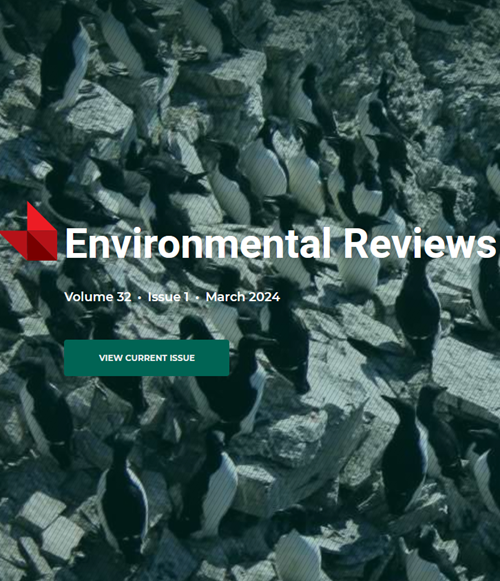A science and management partnership to restore coregonine diversity to the Laurentian Great Lakes
IF 5.1
3区 环境科学与生态学
Q2 ENVIRONMENTAL SCIENCES
引用次数: 2
Abstract
Similar to many freshwater ecosystems, the Laurentian Great Lakes of North America have undergone numerous anthropogenic stressors resulting in considerable loss of biodiversity and habitat. Among Great Lakes fishes, the coregonine sub-family has endured the most extensive declines, including extinction of several species ( Coregonus johannae, C. alpenae, and C. kiyi orientalis) and at least 10 instances of local extirpations of other species ( C. nigripinnis, C. reighardi, C. zenithicus, C. hoyi, and C. artedi) across all 5 lakes, much of which occurred prior to the 1960s owing to overfishing, interactions with non-indigenous species, and habitat loss. Despite these declines, no federal-, provincial-, or state-mandated actions were ever implemented to conserve coregonine diversity, potentially because so much of the coregonine declines occurred prior to the enactment of federal conservation legislation. Possible explanations for inaction since enactment of that legislation include insufficient data on biological vulnerability or threats, unresolved taxonomy, and limited support from the fishery management agencies and their stakeholders prior to the 2000s. In recent decades, however, several fishery management agencies have undertaken efforts to re-introduce coregonine diversity. These efforts helped lead to development of a science-based framework to restore coregonines that was universally endorsed by fishery managers representing eight U.S. states, four U.S. tribal organizations, and the province of ON, Canada, in May 2018. The basin-wide framework is based on principles of conservation biology and adaptive management. We describe details of its key steps, including planning, restoring, and evaluating, while also describing recent implementation efforts to develop methods, improve available resources, and enhance coordination across the basin. Although our paper describes a regional effort to restore native coregonines, our adaptive-management approach could be used by other multi-agency stakeholders seeking to conserve or restore native fishes.恢复劳伦斯五大湖珊瑚原蛋白多样性的科学和管理伙伴关系
与许多淡水生态系统类似,北美洲的劳伦斯五大湖也经历了许多人为压力,导致生物多样性和栖息地的大量丧失。在五大湖鱼类中,coregonine亚科经历了最广泛的衰退,包括几个物种(Coregonus johannae、C.alpenae和C.kiyi orientalis)的灭绝,以及所有5个湖泊中至少10个其他物种(C.nigripinis、C.reighardi、C.zenithicus、C.hoyi和C.artedi)的局部灭绝,其中大部分发生在20世纪60年代之前,原因是过度捕捞、与非本土物种的相互作用以及栖息地的丧失。尽管出现了这些下降,但从未实施过任何联邦、省或州授权的行动来保护coregonine多样性,这可能是因为大部分coregonine下降发生在联邦保护立法颁布之前。自该立法颁布以来无所作为的可能解释包括,关于生物脆弱性或威胁的数据不足,分类法尚未解决,渔业管理机构及其利益相关者在2000年代之前的支持有限。然而,近几十年来,一些渔业管理机构已经努力重新引入珊瑚原蛋白的多样性。这些努力有助于开发一个基于科学的框架来恢复珊瑚原蛋白,该框架于2018年5月得到了代表美国八个州、四个部落组织和加拿大安大略省的渔业管理人员的普遍认可。整个流域的框架基于保护生物学和适应性管理的原则。我们描述了其关键步骤的细节,包括规划、恢复和评估,同时也描述了最近为制定方法、改善可用资源和加强整个流域的协调所做的实施工作。尽管我们的论文描述了恢复本地珊瑚原蛋白的区域努力,但我们的适应性管理方法可供其他寻求保护或恢复本地鱼类的多机构利益相关者使用。
本文章由计算机程序翻译,如有差异,请以英文原文为准。
求助全文
约1分钟内获得全文
求助全文
来源期刊

Environmental Reviews
环境科学-环境科学
自引率
3.50%
发文量
45
期刊介绍:
Published since 1993, Environmental Reviews is a quarterly journal that presents authoritative literature reviews on a wide range of environmental science and associated environmental studies topics, with emphasis on the effects on and response of both natural and manmade ecosystems to anthropogenic stress. The authorship and scope are international, with critical literature reviews submitted and invited on such topics as sustainability, water supply management, climate change, harvesting impacts, acid rain, pesticide use, lake acidification, air and marine pollution, oil and gas development, biological control, food chain biomagnification, rehabilitation of polluted aquatic systems, erosion, forestry, bio-indicators of environmental stress, conservation of biodiversity, and many other environmental issues.
 求助内容:
求助内容: 应助结果提醒方式:
应助结果提醒方式:


